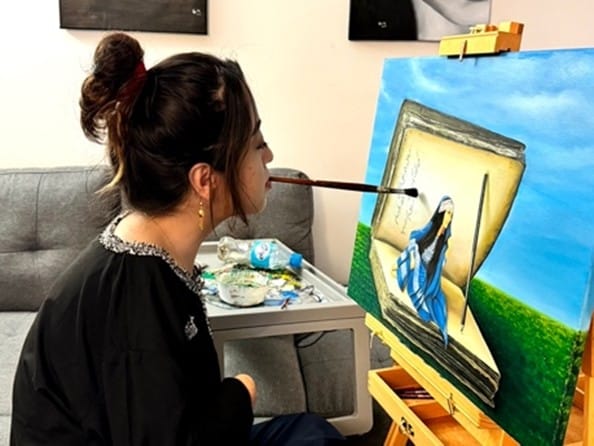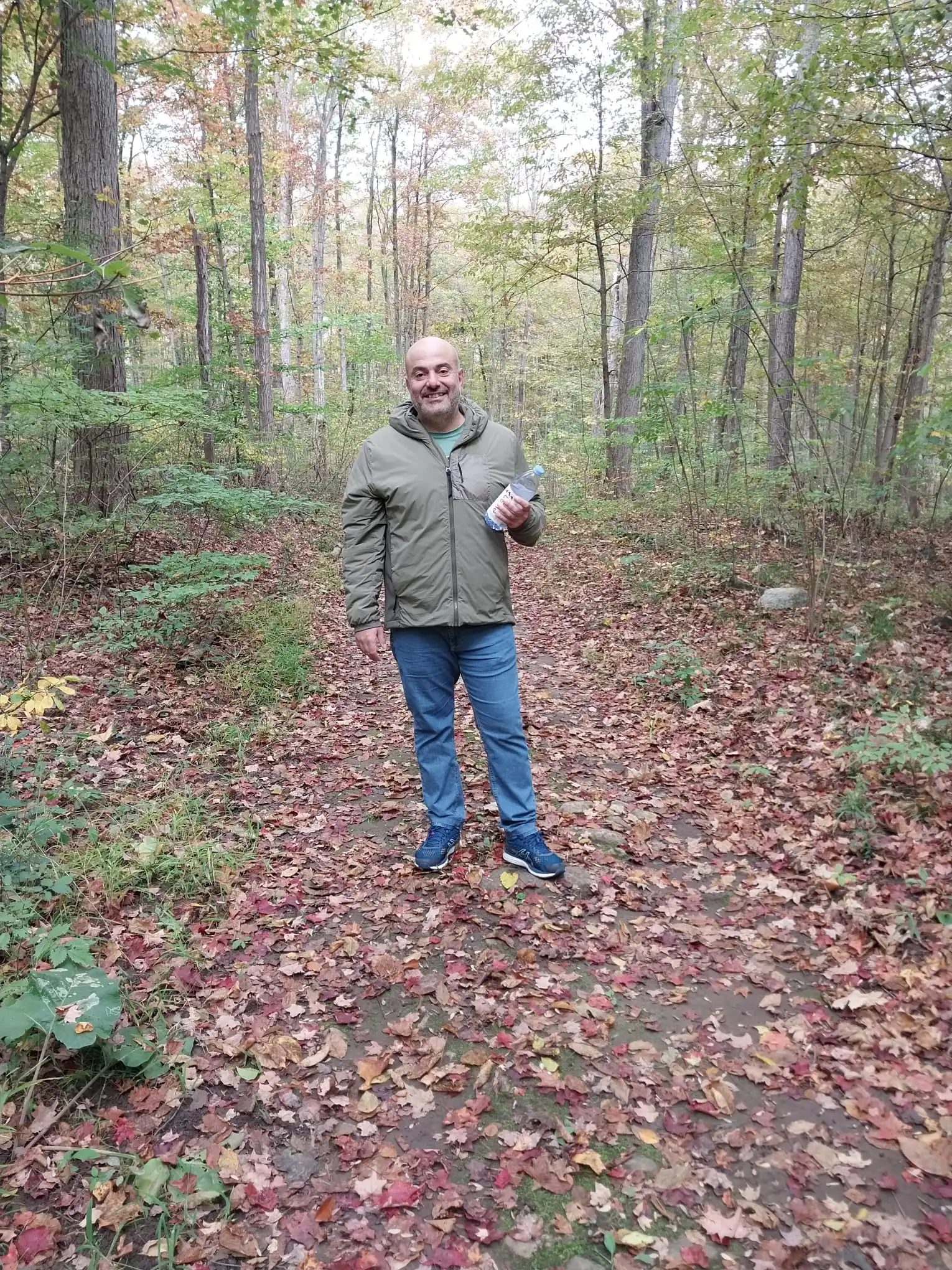
In the quiet town of Malistan, Afghanistan, a girl was born who could neither move her arms nor her legs. From her earliest days, Robaba Mohammadi faced physical challenges that would have daunted even the strongest spirits. Yet, her story is not one of limitation but of extraordinary resilience, creativity, and hope. Today, Robaba stands as a symbol of courage, an artist whose brush defies both the constraints of her body and the turmoil of her homeland.
Her journey—from a lonely childhood shadowed by disability to international recognition as an artist and a refugee rebuilding her life in Canada—is a powerful reminder that creativity and determination can illuminate even the darkest of paths.

Early Life: A Childhood of Isolation and Silent Dreams
Robaba was born on the year 2000 in Malistan, located in Afghanistan’s Ghazni province, where access to healthcare and resources is limited, especially for people with disabilities. From birth, she was unable to move her arms or legs, a condition that physically separated her from the world around her. While her siblings attended school and played outside, Robaba spent many years confined to her home, watching life unfold from the sidelines.
“The other children were going to school, playing, learning. I was alone, watching,” she recalls poignantly.
This isolation could have crushed her spirit, but instead, with the loving support of her younger sister, Robaba began to learn the alphabet. Unable to hold a pen with her hands, she adapted ingeniously, placing the pen in her mouth to start writing and drawing.
“I remember the first time I held a pen with my mouth,” she shares. “I tried to write something, tried to draw a straight line, but it didn’t work. I started to struggle. I felt pity. I said, I am so incapable of holding a pen with my mouth. I am so poor that I can’t use my hands.”
What many would see as a limitation became a testament to her will. Robaba’s early attempts at art were painful and frustrating, yet they were also acts of defiance against the constraints imposed on her body and circumstances.

Discovering Art as a Lifeline
Art entered Robaba’s life not merely as a hobby but as a source of survival. By mid-2015, she had begun painting seriously, despite having no teacher or formal training. Painting became the language through which she expressed what words could not capture: her hopes, her pain, and her dreams.
Her family, too, was influenced by art. “I was not the only one who was influenced by the art of painting. My entire family was influenced by it,” she says. Yet, the environment in Afghanistan, especially during the years of political upheaval, was far from supportive.
“In the last two years I was in Afghanistan, my mental state was very bad. Because the government had changed, and because the artists couldn’t work, they couldn’t even get a simple exhibition,” Robaba explains.
In a country where political instability silenced many artists, Robaba’s only refuge was her canvas. Painting became her therapy, her anchor in turbulent times.
“The only way I had to maintain my mental state was through art. In those last years, I was always at home and only painting. Painting saved me.”

The Challenge of Displacement and New Beginnings in Canada
The fall of the Afghan government and the rise of oppressive regimes forced many, including Robaba, to flee their homeland. Immigrating as a refugee is a profound upheaval. It means leaving behind familiar people, places, and routines for a new, often alien, environment.
For Robaba, this displacement brought a fresh set of challenges: language barriers, cultural differences, and the painful loneliness of separation from family.
“When I emigrated to Canada, I had been away from my family for a year. I was away from my family, and all the loneliness and isolation was only saved by the art of painting,” she reveals.
Adapting to a new country is never easy, especially for someone with a disability and limited physical mobility. Yet, Robaba’s passion for art remained her lifeline.
“Immigration is very difficult. It is very difficult to get used to a country’s culture and laws. It takes time to learn the language. Painting is the only way to save me. I don’t feel weak. I don’t feel sick. I try to maintain my mental health by painting.”
Her words echo the sentiment of many refugees who find that creative expression provides stability amid chaos.

Growing Recognition: From Virtual Followers to International Media
Robaba’s art journey has been a gradual ascent. Starting with no formal guidance and only virtual connections, she devoted countless hours to honing her skills. It took approximately a year and a half for her to gain friends and followers in the virtual world—people who saw her talent and were inspired by her story.
Her work has since appeared in many national and international media outlets, bringing attention not only to her artistic talent but also to the broader struggles and potential of Afghan women with disabilities.
Through social media, Robaba has found a voice that reaches beyond borders. It has enabled her to connect with a wider community, garner support, and inspire others facing similar hardships.
A Vision for Empowering Afghan Women with Disabilities
Beyond her personal achievements, Robaba’s story is also one of advocacy and hope. She aspires to establish a support group to help Afghan women with physical disabilities, a demographic often marginalized and ignored in both Afghan society and the global refugee community.
“I want to set up a support group to help Afghan women with physical disabilities and promote their talent,” she states with conviction.
This vision reflects Robaba’s deep empathy and understanding of the isolation faced by women like herself—those whose abilities are overlooked and whose dreams are often dismissed.
Her advocacy extends the impact of her art from individual survival to collective empowerment.

The Transformative Power of Art and Resilience
Robaba Mohammadi’s life story challenges conventional narratives about disability, refugees, and Afghan women. It is a powerful reminder that human dignity and creativity can flourish even in the harshest conditions.
Her ability to turn physical limitations into artistic expression is awe-inspiring. Her perseverance through isolation, displacement, and cultural barriers shows a remarkable inner strength.
“Painting is the only way to save me,” she says simply. But these words carry the weight of a lifetime of struggle and triumph.
Why Robaba’s Story Matters
In a world often preoccupied with conflict and despair, Robaba’s story is a beacon of hope. It urges us to look beyond disability and refugee status to see the potential within each individual. It reminds us that art is more than beauty—it is healing, resistance, and empowerment.
Robaba Mohammadi is not just an artist. She is a survivor, a mentor, and an advocate for countless women whose voices remain unheard. Her story inspires us to rethink how we support refugees, how we value diversity in ability, and how we create spaces for all voices to be heard.

Final Thoughts
Robaba’s journey—from a child struggling to hold a pen in her mouth, to an internationally recognized artist—embodies the essence of human resilience. It teaches us that with support, creativity, and hope, no barrier is insurmountable.
As Robaba herself hopes, her art and advocacy can open doors for Afghan women with disabilities, giving them not only visibility but also the tools to express their own stories.
Her brush continues to paint a future filled with courage, dignity, and unbreakable spirit.






